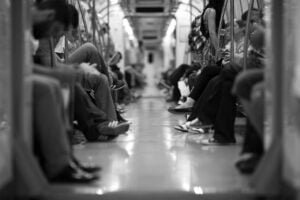By JOHN F. BANZHAF. Originally published at ValueWalk.

1ST Amendment Targeting BLM Paintings Across City Streets – As Predicted; Anti-Abortion Activists and Others Demand Equal Rights Under Constitution
Q2 2020 hedge fund letters, conferences and more
Opposers Using First Amendment To Fight BLM Paintings Across City Streets
WASHINGTON, D.C. (July 23, 2020) - Now that a growing number of cities have permitted activists to paint large signs and murals across entire city streets reading ‘BLACK LIVES MATTER” [BLM] or expressing similar sentiments, those opposed to that use of public streets are fighting back using the First Amendment, says public interest law professor John Banzhaf, who predicted just such a development.
He notes that similar message have been permitted to be painted on streets, sometimes in more than one location, in New York, Boston, Chicago, Cincinnati, Portland, Washington, D.C., and in other localities.
Very recently Rosewood City in California was forced to ban such street paintings, and to paint over a large BLM sign on a city street, when an attorney demanded her First Amendment right to paint her own message, “MEGA 2020,” at another location on same street, or on a nearby street. Banzhaf predicted that others would soon use the same First Amendment approach.
Black Preborn Lives Matter
Now some anti-abortion activists are demanding the right, in the cities of New York and Washington D.C., to paint similar signs across major city streets reading “BLACK PREBORN LIVES MATTER”; which is a much better and probably more effective tactic than simply dumping black paint on them, as one Black women did in New York, or to try to paint over them.
Under current law, it appears that once a city permits one or more of its streets to be painted to reflect a cause, it must provide the same opportunity to similarly situated groups with other causes, says Banzhaf, whose complaint about the need for counter-balancing messages forced radio and TV stations to air hundreds of millions of dollars worth of free antismoking messages before he helped ban cigarette commercials entirely.
Streets have repeatedly been held to be “public forums” by custom and tradition, explains Banzhaf, so that groups can speak (e.g., parade, demonstrate, carry signs, march, etc.) without any governmental restrictions based upon the content or viewpoint of the speech. Thus, if a group wants to demonstrate on public street with the message “BLACK LIVES MATTER,” the city cannot constitutionally prohibit similar demonstrations with messages such as “ALL LIVES MATTER,” “BLUE LIVES MATTER,” or “BLACK PREBORN LIVES MATTER.”
The Different Public Forums
However, since groups have traditionally been permitted to march on public streets with signs supporting various causes, but have not traditionally and by custom been permitted to paint messages on city streets, it can be argued that, such purposes, streets must be considered “limited public forums” or “designated public forums” (not true “public forums”), and therefore subject to different constraints related to limiting speech.
This occurs, explains Banzhaf, when a governmental entity agrees to designate a particular place, not traditionally a public forum for expressive purposes – for example, a municipal building permitting organizations to hold meetings in a large room, or a state university allowing an auditorium to be used by outside organization.
But even under this limited public forum analysis, the government generally cannot impose restrictions based upon the viewpoint expressed or the content of the message conveyed.
For example, the Supreme Court held many years ago that Chattanooga, Tennessee’s municipal auditorium, which the City decided to make available for leasing to present various shows, could not refuse to permit the show “HAIR” to be performed, apparently because the musical expressed strong views opposing the war, in favor of “hippies” with long hair and no jobs, and contained some nudity.
The law related to public transit authorities is also arguably relevant. Since a major Supreme Court decision in 1974, transit authorities have been permitted to accept only commercial and public service oriented advertisements because “a streetcar or bus is plainly not a park or sidewalk or other meeting place for discussion,” but rather “is only a way to get to work or back home.”
Thus, it has been held that Washington, D.C.’s transit system may restrict advertising access “as long as the restrictions are ‘reasonable and [are] not an effort to suppress expression merely because public officials oppose the speaker’s view.'”
On this basis a federal Court of Appeals upheld a rule which provided that “Advertisements that promote or oppose any religion, religious practice or belief are prohibited.”
But, argues Banzhaf, there appear to be no such rules in place in cities where BLM has been permitted to be painted on city streets.
Adopting Reasonable Restrictions
Moreover, while cities, based upon the D.C. case, might be able to adopt reasonable restrictions – e.g., limiting access to non-commercials messages, those posted by tax-exempt organizations, etc. – it is hard to see how cities could permit the painting of “Black Lives Matter” and yet reject requests to paint “All Lives Matter,” “Blue Lives Matter,” or even “White Lives Matter,” “Preborn Lives Matter,” etc.
Organizations which want to post competing messages might wish to contact the ACLU for assistance if their requests for a corresponding opportunity to paint their messages on city streets is denied.
However, it will be interesting to see if the ACLU – which has always proclaimed that the Constitution is our client, and been a strong defender of free speech, even when it was most objectionable – will side with groups which oppose the use of city streets to propagate a message, no matter how worthy that cause might seem to be, says Banzhaf.
The post 1ST Amendment Targeting BLM Paintings Across City Streets appeared first on ValueWalk.
Sign up for ValueWalk’s free newsletter here.



